It was a long, dry summer, filled with exhaustion and writing inertia of sorts. For someone who needs connection with the world to stimulate the imagination, sheltering from any possible exposure to COVID19 did not help. But as of this last week, I’ve had some movement. I’ve had two opinion articles published in The Insider within two weeks: Can There Be Truth without Ruth? and Bob Woodward: A Day Late, But Not a Dollar Short. This is a new kind of venue for me, adding journalistic writing to my fiction work. It’s also a chance–especially in these isolating COVID19 days we are living through–to express my views to more than the walls of my apartment. (With the amount of yelling I’ve been doing at those walls, I’m surprised that, like Jericho’s, they have not come tumbling down.)
In addition, yesterday, I received the lovely news that an excerpt of one of my novels is a finalist for a contest conducted by Novel Slices. If the excerpt should win, it would be one of five that will appear in that publication. (I am torn between wanting to celebrate that news and not wanting to jinx myself. ) Here’s hoping!
Category Archives: miscellaneous
Tinker’s Damn — Close, But Still No Cigar…
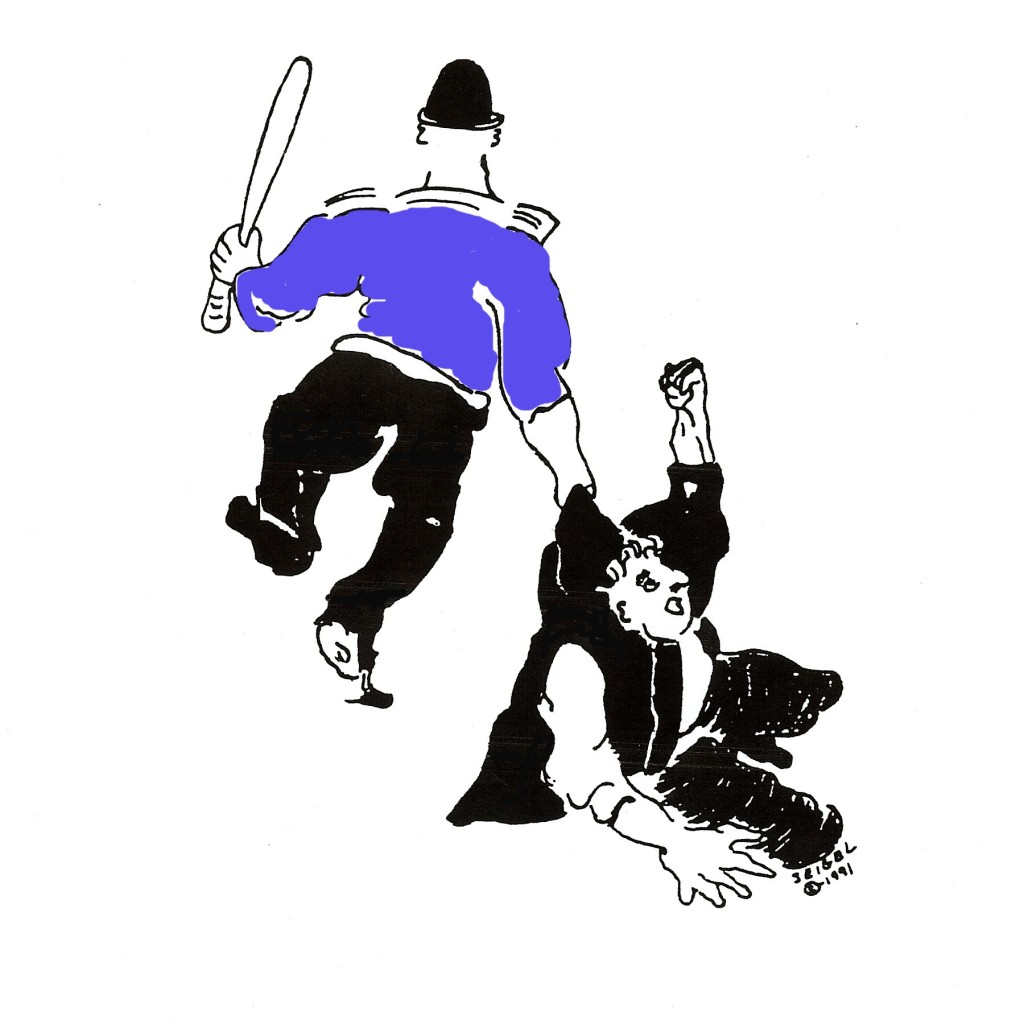
The road to publication is long and slow even for work that many recognize has worth. In the category of “close but no cigar,” my novel, Tinker’s Damn, was not chosen by Forest Avenue Press for publishing. But Tinker’s Damn DID make it into Forest Avenue Press’s top 20 novels considered for publication during its open reading period, adding to the other affirmations this novel has received, even though it has yet to find a home. (i.e., it was a semi-finalist for the William Faulkner Creative Writing Award for the Novel; an excerpt was published in Ontario Review; and it has been equated with Seamus Heaney’s poetry in Sweeney Astray.)
New Story Out–The Pickpocket of Prague
My short fiction, The Pickpocket of Prague, just came out today at Every Day Fiction. The story is based, very loosely (wink), on an experience I had when in Prague in 2001. I was in a writing seminar there, and the instructor assigned us to write a story “from the point of view of a person you hate.” I did not exactly hate these people, but I was trying to assume their likely point of view.
My Wanderings Past New York’s Public Art
We all know that New York’s major museums and private galleries make the city one of the great artistic centers of the world. For the most part, though, I deliberately did not spend my time at those venues during this disjointed sojourn in New York. Instead, I wandered the streets, noting public art that was whimsical and affecting. Here are some of the artworks I saw:
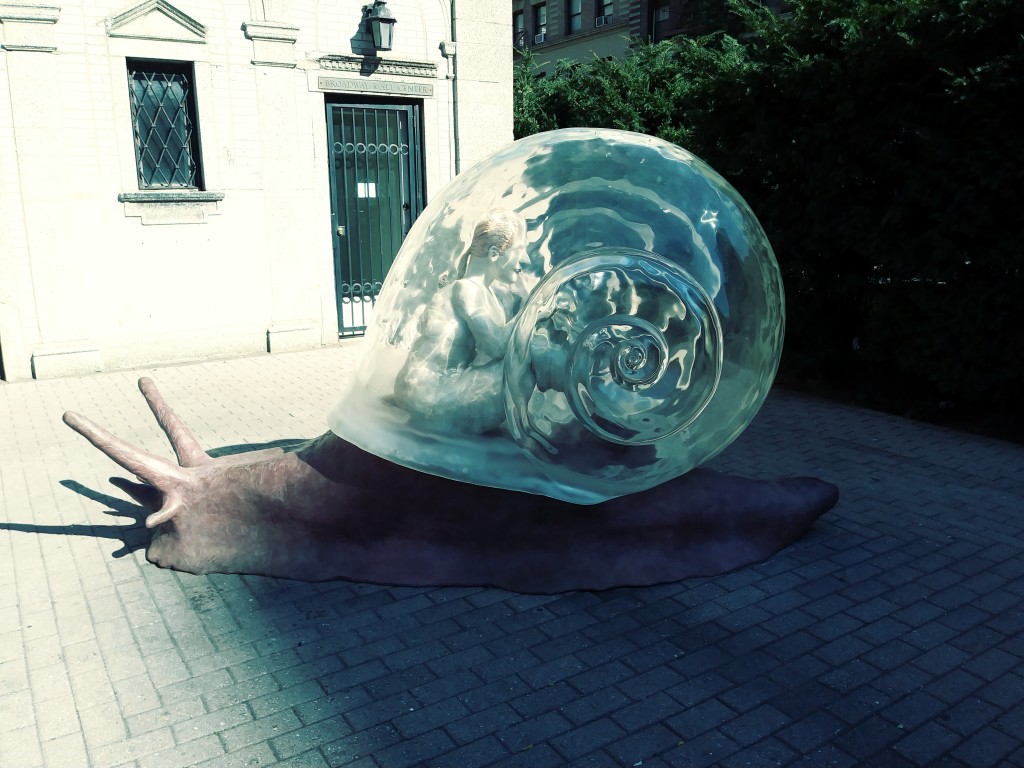
A snail on the meridian at West 96th street and Broadway. (Note the naked lady sitting inside the snail’s shell.)

A statue of Ralph Kramden, bus driver, from the tv show, The Honeymooners, stands outside the Port Authority Bus Station.

Light moving through colored glass circles embedded in metal, on a square in the Battery area.
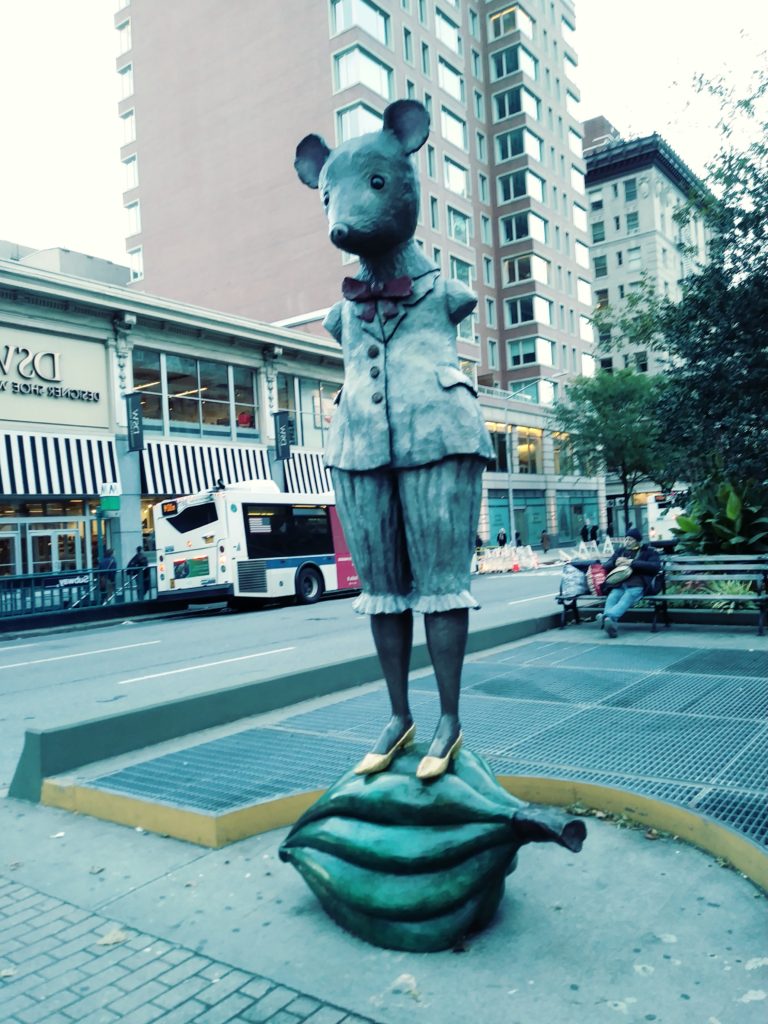
A mousey, on the meridian near Broadway and West 81st street.

New York’s Korean War Veteran’s memorial, in the Battery area. (Presenting the soldier as a missing space is quite affecting, as is the view through him of tree and sky; some sad sense of the eternal there.)
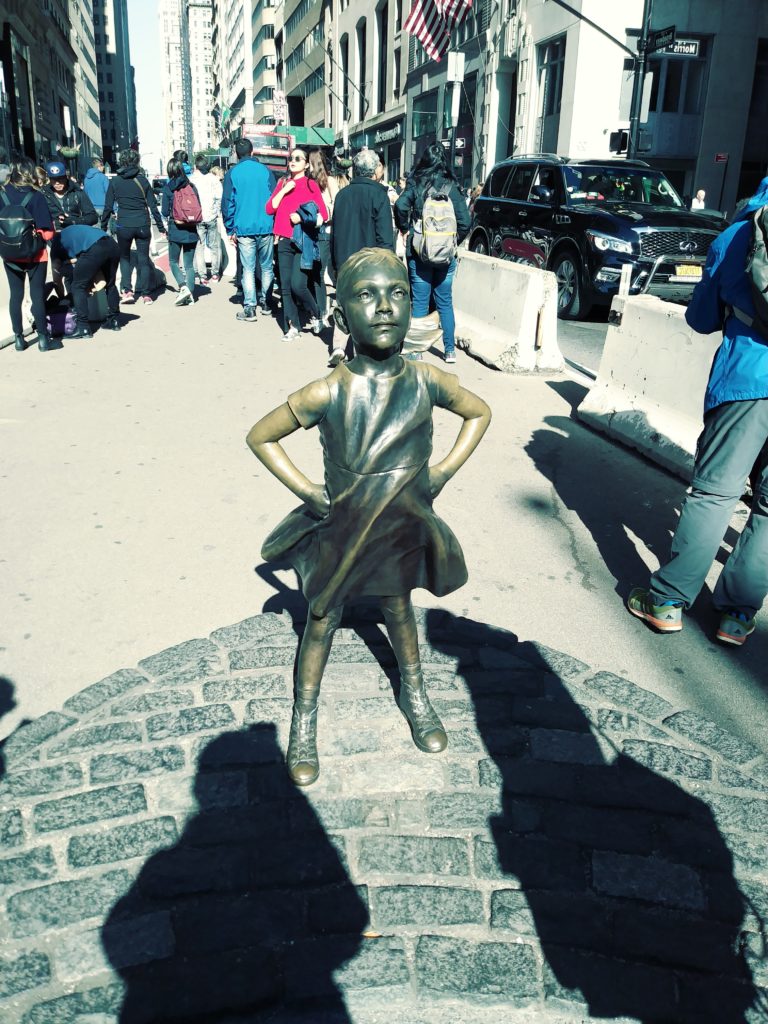
It is a well-known piece of public art at this point, but who could resist displaying this little bundle of defiance standing against the Wall Street Bull!
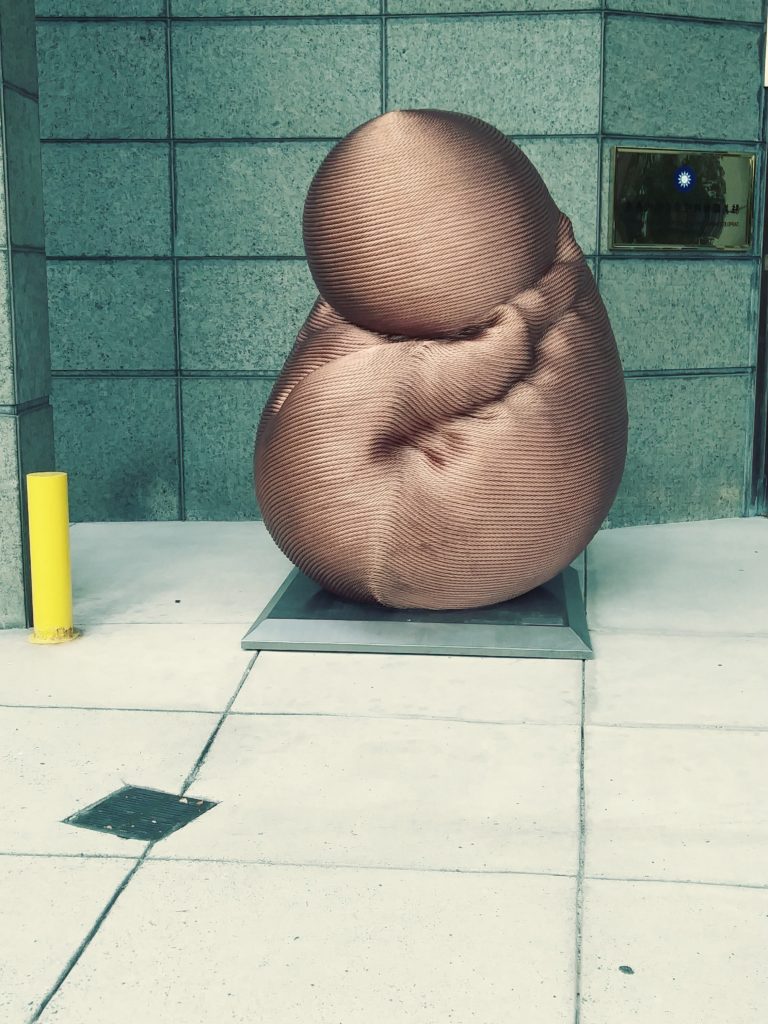
And somewhere on Eighth Avenue, I think–I have no idea what it is, but it is interesting, no? Like some creature curled up into a tight hug.
There was also an interesting exhibit of work by Bernie Leahy in a one-room gallery at the Irish Arts Center, what the artist calls “stitched drawings.” Even when quite close to the work, one must strain to see that they are stitched with thread or yarn and not drawn with pen, pencil or painted. Here are a couple of examples:
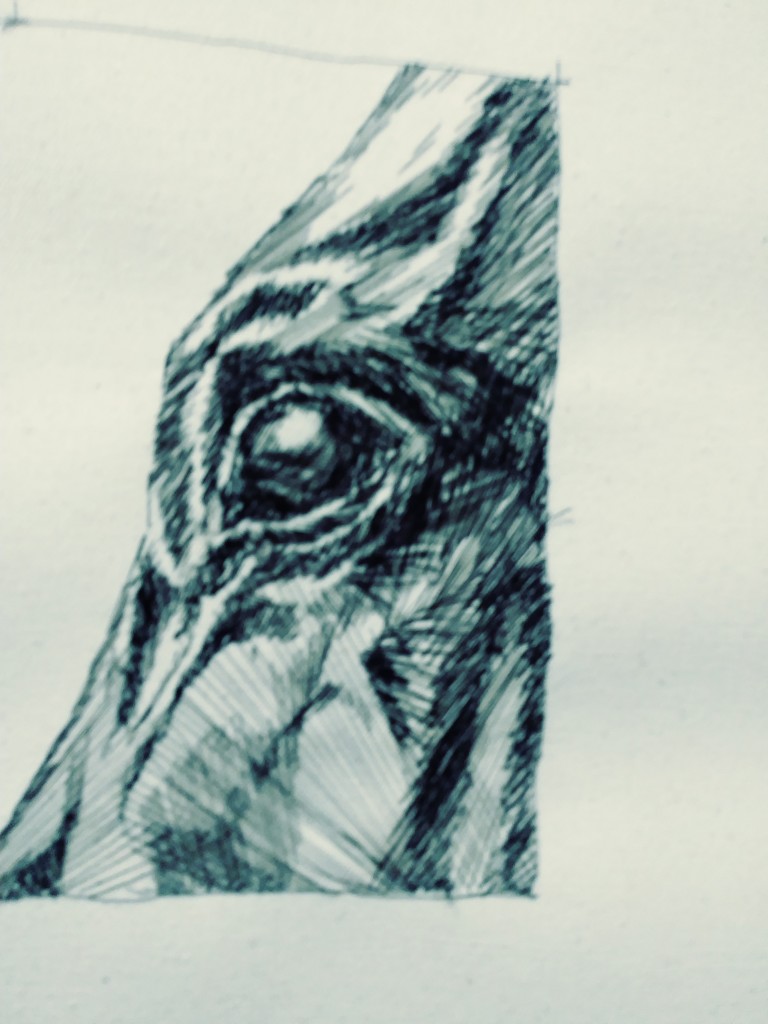
 And also, just for fun–from the same Bernie Leahy exhibit, lips stitched in…
And also, just for fun–from the same Bernie Leahy exhibit, lips stitched in…

They have an anthropomorphized look, don’t they? It’s as if the fastened buttons are of a blouse fastening just below the neck. And lips being inserted, one wants to supply eyes; and the eyes being missing makes it feel like the gloves are blind or blindfolded. Am I deceived, or does there appear to be a chin below the lips?
New York City: On Polaris North
In my first week in NYC, I went, with my friend Camille, to The Liar’s Show, down on the Lower East Side. Four storytellers told stories and the audience voted on who was lying. Afterwards we went to dinner with some of the organizers and I ended up in conversation with one of the storytellers and his mother who, it turns out, is an actress. She told me of Polaris North, a group of playwrights and actors. She told me that the public could attend readings there (the audience is asked for feedback to help the playwright improve the play), and that one could also audit their workshops a couple of times before joining.
Not living in New York, it did not make sense for me to join. But, when I returned for my second two weeks in the city I attended a public reading at Polaris North, and was invited to approach the workshop leaders to audit while I was in town. I did. The workshop leaders and the members were extremely welcoming.
On a Saturday, I audited a playwrights’ bootcamp, a workshop lasting for about four hours. This was very much like a regular fiction workshop, except that the roles were read aloud by the various members attending before the group and leader critiqued the work.
On the following Monday, I audited an actor’s workshop. I’m sure that, for actors, it probably would have been commonplace. But, unlike the playwrights workshop, this was, for me, a new experience, and I found it fascinating. An actor would perform a prepared monologue. The leader and the group would critique the performance. The leader might say, “no–too much. Do less.” Or, “no, not strong enough. Give it more.” And the actor would immediately redo the monologue with a slightly different take, often subtly but identifiably different. One actor redid her monologue several times, and each time there were subtle but varied interpretations that gave distinctly different nuances to the character.
In the book Stella Adler on America’s Master Playwrights, edited by Barry Paris, Adler says of the actor, “Your job is not to ‘act.’ Your job is to interpret.” She notes, “That histrionic side of the actor is what he is and what he adds to the play. The play is dead. It lies there. The other side is the side that people fool around with.” I’m not sure I’d call a completed play “dead.” But (except for out-of-town try-outs and resulting rewrites), it is complete. Done. Something that the director and actors will now make their own. It is a matter that writers of novels, short stories or other sorts of literature do not need to consider. Observing the way in which the actors at Polaris North “fooled around with” their monologues was instructive to me–indeed to anyone who is not already in theater–who may decide to write plays. One must recognize that they need to leave space for the actor to interpret.
New York Sojourn, Continued…
The original plan was to spend 28 days in New York City and write about it day by day. The impossible situation at my first place of stay (see last post) made that impossible. Between the mouse in the kitchen repeatedly darting from under the refrigerator to under the stove, the little dog piddling on my floor, the front door to the apartment being unlocked 24/7, the mother–though friendly enough–making eternal excuses for everything–and finally, an argument in the hall of the apartment outside my room that made me concerned that her son and his friend were using hard drugs, I had to leave. A friend had me stay with her for two days while we tried to find a new place for me to rent, but we failed. I went home feeling a bit defeated. BUT–another friend came up with some new possible places to live. So, after a week at home, I went back for another two weeks, salvaging much of the month, but also squeezing a month’s worth of activity into two weeks. I accomplished a lot.
(Of course, there was the day I came home to the new place on a Friday afternoon–a very lovely studio apartment with an eviction notice taped to the door that ostensibly gave one three days to vacate. That would have meant Monday. You’ve got to be kidding me!–my first, exasperated reaction. After only one week back in NYC, I might have to leave yet again? It did get resolved. First, there were thirty days for the notice to be questioned or appealed. I would be gone by then. And, ultimately, it turned out that the rent had been paid but had probably crossed in the mail with the notice. Still, it did not help make for a relaxed, un-stressful month.)
Nevertheless, those two weeks were filled with auditing of workshops (both playwrights and actors), attending several staged play readings, visits to a Chagall exhibit at the Jewish Museum, a visit to the Irish Arts Center, and to the Drama Bookshop, as well as time spent with artist and writer friends, and with relatives. And then, of course, the bomb threats to CNN and Robert De Niro, and the rest occurred while I was in New York, as well as the terrible event at the Pittsburgh synagogue.
Next: elaboration on the best of my New York adventures…
DAY FOUR-NEW YORK DIARY (October 4th)
On Day Three, there had been some strange goings-on in the apartment where I was staying. A rug in the bathroom, which I was sharing with the son of the house and a friend who was living there with them, was utterly soaked. Then I noticed a plunger lying on the floor. So, concerned about sanitation, I went to ask whether the son whether the toilet had overflowed. His friend responded like he was puzzled. But the son barked “NO!” And did so too quickly.
In the evening, the mother decided to close the windows in her bedroom and turn on the air-conditioning because it was hot and humid. I asked if they we could do the in my room too. She had her son close the window in both rooms. When I went into my room later, he had closed the window and turned on the air conditioning for me. But, there was a mysterious puddle on the floor, as there had been on my first day there, but at a different spot. It is possible–most likely probable–that their small dog had followed him into the room and had an accident. But for a moment, I had an uneasy slightly paranoid feeling that the son might have done something to get even with me for asking about the toilet. Itchy, I know. But it passed through my mind. Whatever the source of the mysterious puddles, I spent a portion of Day Four shopping for slippers so I would not have to walk barefoot on the floors.
But, along the way, I saw the wonderful Jerome Robbins exhibit at the New York public library of the performing arts located at Lincoln Center. His choreography–his form of dance–is so free, and such a mix of ballet with modern, and so much building an American identity for dance. The exhibit contains an essay he wrote in high school about his own many “masks,” film footage with accompanying music of a number of his ballets, including Fancy Free, as well as the beginning piece of West Side Story, and one wall explains how he and others went about transferring West Side Story from stage to screen, including the search for locations that would give the sense of freedom while providing a necessary frame so the dances were not lost in the breadth of the scenes.
In late afternoon, I got a call from a cousin with an impromptu invitation to a play that night: The Lifespan of a Fact, a 3-person play starring Daniel Radcliffe, Cherry Jones, and Bobby Cannavale. It’s theme: “truth” vs. “fact.” Philosophical. Cerebral. But, in today’s atmosphere of “alternate facts” and lies, it takes on a political relevance as well.
